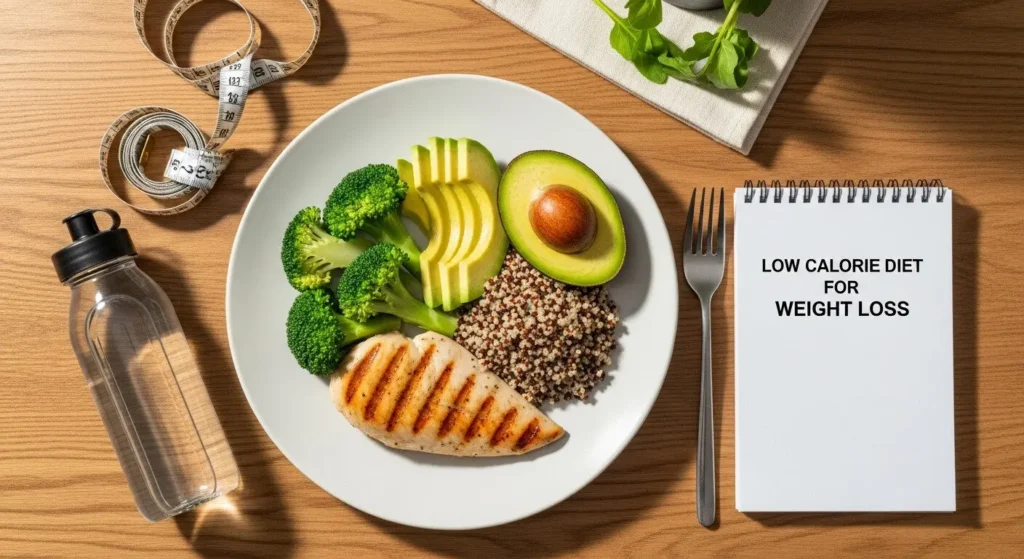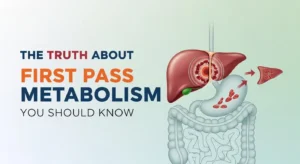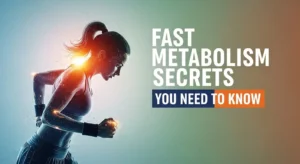Are you looking to shed some extra pounds and feel better? A low calorie diet for weight loss might be just what you need. It’s a straightforward approach: eat fewer calories than your body uses, and you'll lose weight. But like any diet, it needs to be done the right way to be safe and effective.

This guide will walk you through everything you need to know about starting a low calorie diet for weight loss, from figuring out your calorie needs to choosing the right foods and sticking with it for the long run. Get ready to learn how to make smart choices and see real results!
Key Takeaways
- Understand Calories: Weight loss happens when you eat fewer calories than your body burns, creating a “calorie deficit.
- Calculate Your Needs: Use a calculator to find your Basal Metabolic Rate (BMR) and Total Daily Energy Expenditure (TDEE) to set a safe and effective calorie target.
- Focus on Nutrients: Prioritize lean proteins, fruits, vegetables, and whole grains. These foods fill you up without adding too many calories.
- Plan Ahead: Meal planning, prepping, and portion control are key to staying on track and avoiding unhealthy choices.
- Stay Hydrated & Active: Drinking plenty of water helps with hunger, and adding some exercise boosts your calorie burn and overall health.
What Exactly Are Calories and Why Do They Matter?
Think of calories as the “fuel” your body uses. Everything you eat and drink has calories. Your body needs these calories for all its functions, from breathing and thinking to walking and exercising.
When you eat more calories than your body uses, your body stores the extra energy, usually as fat. When you eat fewer calories than your body uses, your body starts to burn its stored fat for energy. This is called creating a calorie deficit, and it's the main secret to weight loss.
For example, if you consistently eat 500 fewer calories than your body burns each day, you could lose about 1 pound of fat per week. This is because 1 pound of fat is roughly equal to 3,500 calories. So, 500 calories/day x 7 days/week = 3,500 calories/week. Simple math, big results!
Your Body's Energy Needs
Your body burns calories even when you're just resting. This is your Basal Metabolic Rate (BMR) – the calories your body needs to keep your heart beating, lungs breathing, and brain working. On top of your BMR, you burn more calories through daily activities and exercise. This total is your Total Daily Energy Expenditure (TDEE).
To start a low calorie diet, you first need to get an idea of your TDEE. Then, you can plan to eat fewer calories than that number.
Is a Low Calorie Diet Right for You?
A low calorie diet can be a very effective way to lose weight. However, it's not for everyone, and it's important to approach it safely.
Who might benefit from a low calorie diet?
- People who are higher weight need to lose a significant amount of weight.
- Individuals looking for a structured way to manage their food intake.
- Those who are ready to make consistent changes to their eating habits.
Who should be careful or avoid it?
- Pregnant or breastfeeding women.
- Children and teenagers (unless guided by a doctor).
- People with certain medical conditions like diabetes, heart disease, or eating disorders.
- Individuals taking specific medications.
Always talk to your doctor or a registered dietitian before starting any new diet, especially a low calorie one. They can help you figure out a safe and healthy calorie target that fits your body and health needs. Your health is the most important thing! 🩺
Calculating Your Calorie Needs for Weight Loss
This is a crucial step! To lose weight safely, you need to know how many calories your body needs and how many you should aim for.
First, you'll estimate your Basal Metabolic Rate (BMR), then your Total Daily Energy Expenditure (TDEE), and finally, create a calorie deficit.
Here's how it generally works:
- Calculate your BMR: This is the number of calories your body burns at rest.
- Calculate your TDEE: This is your BMR plus the calories you burn from daily activities and exercise.
- Create a Deficit: Subtract a certain number of calories (usually 500-750) from your TDEE to get your daily target for weight loss.
To make this easier, here's an interactive calculator. Input your details to get an estimate of your calorie needs and a suggested target for weight loss!
Calorie Needs Calculator
Enter your details and click ‘Calculate' to see your estimated calorie needs.
*Disclaimer: This calculator uses standard formulas (Mifflin-St Jeor) and provides estimates. For personalized advice, consult a healthcare professional or registered dietitian.
What to Eat on a Low Calorie Diet
Choosing the right foods is just as important as counting calories. You want foods that are nutrient-dense (packed with vitamins and minerals) and filling (high in fiber and protein) but low in calories. This helps you feel full and satisfied without going over your calorie limit.
Here's a list of foods to focus on:
1. Lean Proteins
Protein helps you feel full longer and helps keep your muscles strong, which is important during weight loss.
- Chicken breast (skinless)
- Turkey
- Fish (like cod, tilapia, salmon – salmon has healthy fats, so portion size matters)
- Eggs
- Beans and lentils
- Tofu and tempeh
- Greek yogurt (plain, low-fat)
- Cottage cheese
2. Fruits and Vegetables
These are your best friends on a low calorie diet! They are high in fiber and water, which fill you up, and they're packed with essential vitamins and minerals. Eat a wide variety of colors!
- Leafy greens: Spinach, kale, lettuce
- Broccoli, cauliflower, Brussels sprouts
- Bell peppers, cucumbers, tomatoes
- Berries: Strawberries, blueberries, raspberries
- Apples, oranges, pears
- Watermelon and cantaloupe (high water content)
3. Whole Grains (in moderation)
While healthy, whole grains still have calories, so watch your portion sizes. They provide fiber and sustained energy.
- Oats
- Quinoa
- Brown rice
- Whole-wheat bread or pasta (small portions)
4. Healthy Fats (in small amounts)
Fats are calorie-dense, but healthy fats are important for your body's functions. Use them sparingly.
- Avocado (a quarter or half)
- Nuts and seeds (a small handful)
- Olive oil (a teaspoon or two for cooking or dressing)
“Eating fewer calories doesn't mean eating less food. It means choosing foods that are naturally lower in calories but still fill you up, like fruits, vegetables, and lean proteins.” — Healthy Eating Coach
Foods to Limit or Avoid
To stick to your calorie goals, it's wise to cut back on or avoid foods that offer many calories but little nutrition.
- Sugary drinks: Sodas, sweetened teas, fruit juices (even 100% juice can be high in sugar and calories)
- Processed snacks: Chips, cookies, cakes, pastries
- Fast food and fried foods: Often high in unhealthy fats and calories
- Excessive unhealthy fats: Too much butter, creamy sauces, fried foods
- Alcohol: Contains “empty” calories and can lower your inhibitions, leading to poor food choices
| Food Category | Focus On (Low Calorie) | Limit/Avoid (High Calorie/Low Nutrition) |
|---|---|---|
| Proteins | Lean chicken, fish, tofu, beans, egg whites | Fatty cuts of meat, processed meats (sausage, bacon), fried chicken |
| Fruits & Veggies | All fresh fruits & non-starchy vegetables | Canned fruits in syrup, fried vegetables (e.g., French fries) |
| Grains | Oats, quinoa, brown rice, whole-wheat bread (small) | White bread, sugary cereals, pastries, large pasta portions |
| Fats | Small amounts of avocado, nuts, seeds, olive oil | Deep-fried foods, butter, creamy dressings, processed snack foods |
| Drinks | Water, unsweetened tea, black coffee | Sugary sodas, fruit juices, sweetened coffee drinks, alcohol |
Meal Planning and Preparation for Success
Success on a low calorie diet often comes down to planning. When you plan your meals, you're less likely to make impulsive, unhealthy choices.
- Plan Your Meals:
- Set aside time each week to plan your meals for the next few days.
- Consider your calorie target for each meal and snack.
- Use a food diary or a tracking app to log your meals and stay accountable.
- Think about variety to get all your nutrients and prevent boredom.
- Grocery Shopping Smart:
- Make a grocery list based on your meal plan and stick to it.
- Shop the perimeter of the grocery store first (where fresh produce, lean meats, and dairy are).
- Avoid shopping when you're hungry! 🛒
- Batch Cooking:
- Cook larger portions of healthy proteins (like grilled chicken or lentils) and whole grains (quinoa, brown rice) at the beginning of the week.
- Chop vegetables ahead of time.
- This saves time and makes it easier to quickly assemble healthy meals.
- Portion Control:
- Even healthy foods have calories. Use measuring cups and a food scale, especially when you're starting out, to get a good idea of proper portion sizes.
- Smaller plates can also help trick your brain into thinking you have more food.
Hydration: Your Secret Weapon
Water is incredibly important for weight loss and overall health.
- Fills you up: Sometimes, your body confuses thirst with hunger. Drinking water before meals can help you eat less.
- Boosts metabolism: Water is essential for many bodily functions, including metabolism.
- Helps digestion: Fiber works best when you're well-hydrated.
- Replaces sugary drinks: Choose water over sodas or juices to save a lot of calories.
Aim for at least 8 glasses (about 2 liters) of water a day, and more if you're exercising or it's hot. Keep a water bottle handy!
Exercise and Activity: The Perfect Partner
While diet is key for weight loss, adding exercise can speed up your progress and boost your health in many ways.
- Burns extra calories: This helps create a bigger calorie deficit.
- Builds muscle: More muscle means your body burns more calories, even at rest.
- Improves mood: Exercise releases feel-good chemicals.
- Boosts energy: Helps counteract any fatigue from a calorie deficit.
You don't need to become a gym fanatic overnight. Start small:
- Go for a brisk walk for 30 minutes a day.
- Try some bodyweight exercises at home.
- Take the stairs instead of the elevator.
Even a 3-day fast can be a way to kickstart rapid weight loss, but it's important to understand it's a short-term strategy and not a substitute for a balanced, long-term low-calorie diet and consistent exercise.
Dealing with Hunger and Cravings
It's normal to feel a bit hungry or have cravings when you're eating fewer calories. Here are some tips:
- Eat fiber-rich foods: Fruits, vegetables, and whole grains keep you full.
- Prioritize protein: Protein is the most satisfying macronutrient.
- Drink water: As mentioned, sometimes you're just thirsty.
- Plan healthy snacks: Keep options like apple slices, carrots, or a handful of almonds ready.
- Mindful eating: Eat slowly, pay attention to your food, and stop when you feel satisfied, not stuffed.
- Distraction: If a craving hits, try doing something else for 10-15 minutes – go for a walk, read a book, or call a friend.
Monitoring Progress and Adjusting
Weight loss isn't always a straight line. There will be ups and downs.
- Weigh yourself regularly, but not daily: Once a week, at the same time of day (e.g., Monday morning after using the restroom), is usually best. Don't get discouraged by small fluctuations.
- Take measurements: Your waist, hips, and other areas might shrink even if the scale doesn't move much.
- Take progress photos: Sometimes seeing the visual change is the most motivating.
- Adjust if you hit a plateau: If your weight loss stops for a few weeks, you might need to slightly reduce your calories further, increase your activity, or re-evaluate your food choices. Your body adapts over time.
For some, supplements like Liv Pure are explored to support weight loss efforts, but it's essential to understand that they are meant to complement, not replace, a healthy diet and lifestyle.
Potential Challenges and How to Overcome Them
Starting a low calorie diet can present some hurdles. Knowing them beforehand helps you prepare.
- Fatigue or Low Energy: In the beginning, you might feel a bit tired. Make sure you're getting enough sleep and eating nutrient-dense foods. If it continues, check with your doctor.
- Nutrient Deficiencies: If your diet is too restrictive or lacks variety, you might miss out on important vitamins and minerals. This is why focusing on whole, unprocessed foods is crucial. A multivitamin can be a backup, but whole foods are always best.
- Social Eating: Eating out or at social gatherings can be tricky. Look at menus online beforehand, choose lighter options, don't be afraid to ask for sauces on the side, and practice mindful eating. You don't have to miss out on social life!
- Feeling Deprived: If you feel like you're constantly missing out, you're more likely to give up. Allow yourself occasional small treats in moderation, or find healthy versions of your favorite comfort foods.
Sustainability and Long-Term Success
A low calorie diet isn't meant to be a permanent state. Once you reach your goal weight, you'll need to transition to a maintenance phase.
- Gradual Increase: Slowly add calories back into your diet until you find the amount that maintains your new weight.
- Maintain Healthy Habits: The habits you built during weight loss – mindful eating, portion control, regular activity, healthy food choices – are the key to keeping the weight off for good.
- Listen to Your Body: Learn to recognize true hunger and fullness cues.
Beyond Weight Loss: Holistic Health
While weight loss is a fantastic goal, remember it's one part of your overall health journey. Taking care of your body means looking at all aspects of well-being, from mental health to specific bodily functions. For men, this includes paying attention to areas like prostate health, which becomes more important with age. You can learn more about the most effective prostate supplements reviewed for 2025 and explore options like Prostavive for tackling prostate problems head-on. A comprehensive guide to prostate supplements can also help you understand your choices better for a complete approach to wellness.
When to Seek Professional Help
While this guide provides a great starting point, sometimes you need extra support.
- Registered Dietitian: They can create a personalized meal plan, teach you about nutrition, and help you overcome challenges.
- Doctor: Always consult your doctor before starting any significant diet change, especially if you have underlying health conditions. They can monitor your health and ensure the diet is safe for you.
- Therapist or Counselor: If you struggle with emotional eating, body image issues, or have a history of eating disorders, professional psychological support can be invaluable.
Conclusion
Starting a low calorie diet for weight loss can be a powerful step towards a healthier you. It's about more than just numbers; it's about making smart food choices, understanding your body's needs, and building sustainable habits. Remember to focus on nutrient-rich foods, plan your meals, stay hydrated, and move your body. Be patient with yourself, celebrate your small wins, and don't hesitate to seek professional guidance if you need it. You've got this! Your journey to a healthier, happier you starts now.








